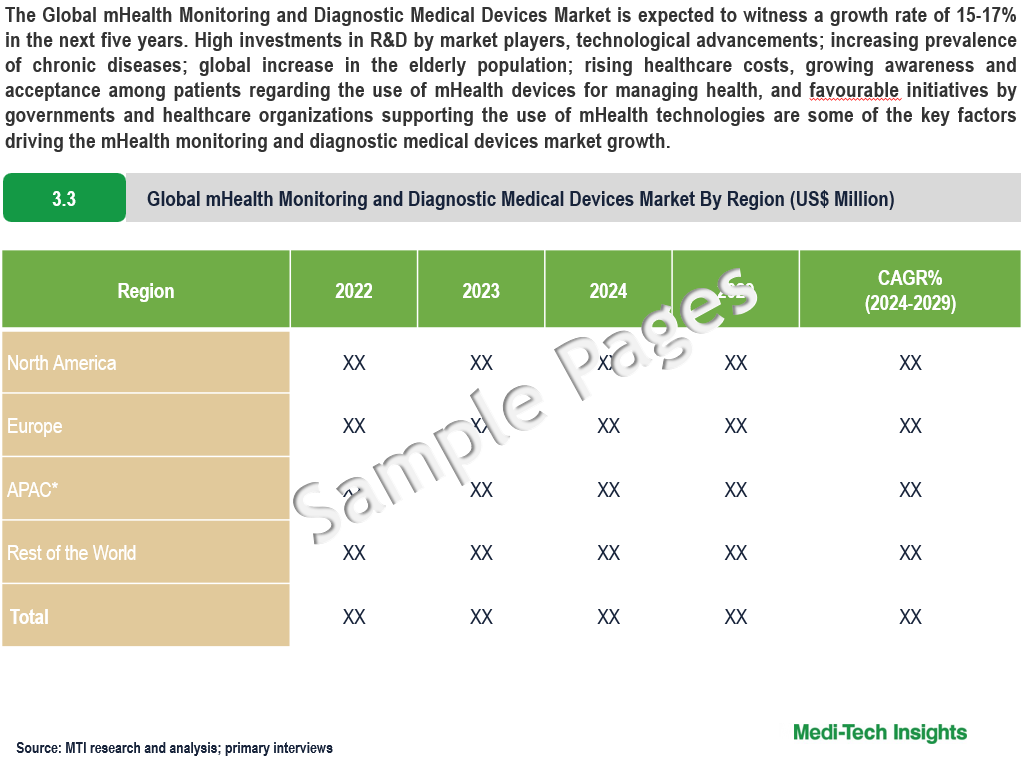
mHealth Monitoring and Diagnostic Medical Devices Market Size, Trends, Growth Analysis for Forecast by 2029
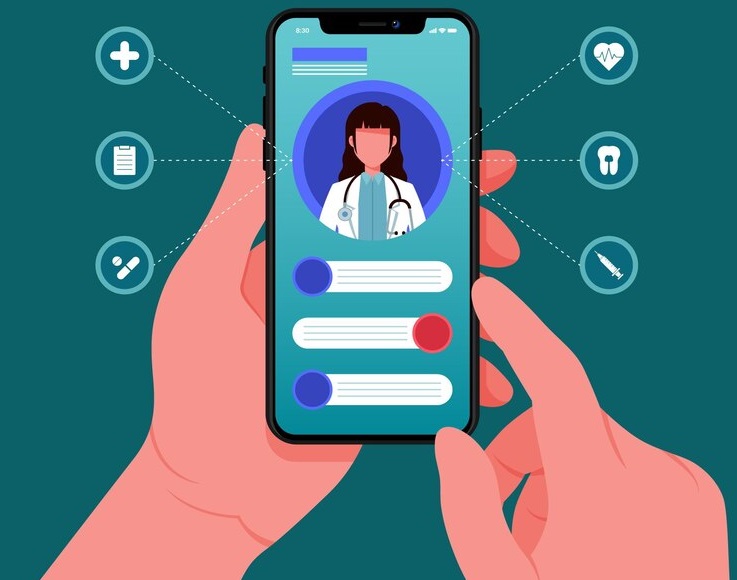
The Global mHealth Monitoring and Diagnostic Medical Devices Market is expected to witness a growth rate of 15-17% in the next five years. High investments in R&D by market players, technological advancements; increasing prevalence of chronic diseases; global increase in the elderly population; rising healthcare costs, growing awareness and acceptance among patients regarding the use of mHealth devices for managing health, and favourable initiatives by governments and healthcare organizations supporting the use of mHealth technologies are some of the key factors driving the mHealth monitoring and diagnostic medical devices market growth. However, concerns regarding data privacy and security, high cost of advanced mHealth devices, uncertain regulations and standards, technical limitations and interoperability issues are some of the factors likely to hinder the market’s growth. To learn more about the research report, download a sample report.
mHealth Monitoring and Diagnostic Medical Devices are mobile health technologies that utilize smartphones, wearables, and connected sensors to track and diagnose various health parameters in real-time. These devices enable remote monitoring, personalized healthcare, and timely medical interventions, improving patient outcomes by providing continuous, data-driven insights into chronic conditions and overall wellness.
Technological advancements to Drive Market Growth
Technological advancements are a key driver for the mHealth Monitoring and Diagnostic Medical Devices market by enabling more sophisticated, user-friendly, and accurate mHealth monitoring solutions. The proliferation of smartphones and wearables, equipped with advanced sensors and connectivity, allows continuous and real-time tracking of vital health metrics such as heart rate, glucose levels, and physical activity. Integration of the internet of things (IoT) facilitates seamless data transfer between devices and healthcare systems, enhancing remote patient monitoring and telemedicine services. Additionally, advancements in artificial intelligence and machine learning enhance the diagnostic capabilities of mHealth devices, enabling predictive analytics and personalized healthcare. These technologies empower patients to take proactive control of their health, leading to improved engagement and adherence to treatment plans. Furthermore, the development of more cost-effective and energy-efficient components has made these devices more accessible, driving market growth and expanding their reach to a broader population.
“Mobile health (mHealth) with continuous real-time monitoring is at the forefront of digital medical convergence. Wearable devices and smartphones, optimized as personalized health management platforms, are transforming the landscape by enabling disease prediction, prevention, diagnosis, and even treatment. These ubiquitous and accessible medical services offered through mHealth are crucial in strengthening universal health coverage, ensuring equitable access to healthcare for all"- Chief Technology Officer, A Global mHealth Device Manufacturer, United States
High Investments in R&D by Market Players to Fuel Market Growth
High investments in R&D by market players significantly drive the mHealth monitoring and diagnostic medical devices market by fostering innovation and advancing technology. these investments enable the development of cutting-edge devices with improved accuracy, reliability, and user-friendliness. Enhanced R&D facilitates the integration of sophisticated sensors, advanced AI algorithms, and seamless IoT connectivity, making devices more effective for real-time health monitoring and diagnostics. Moreover, substantial R&D funding accelerates the creation of new solutions tailored to meet diverse patient needs, addressing chronic disease management, remote patient monitoring, and personalized healthcare. It also supports rigorous testing and validation processes, ensuring compliance with regulatory standards and enhancing market credibility. By pushing the boundaries of what mHealth devices can achieve, high R&D investments attract healthcare providers and consumers alike, driving market growth and expanding the reach of these innovative medical technologies.
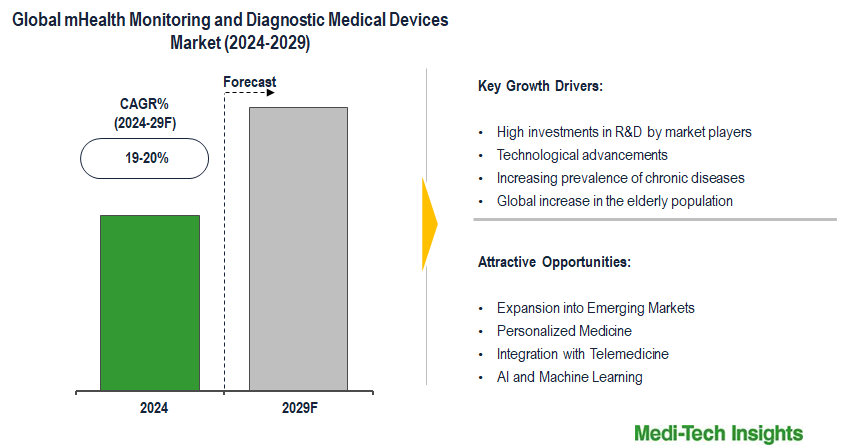
To learn more about this report, download the PDF brochure
Technological Innovations are Driving the mHealth Monitoring and Diagnostic Medical Devices Market
The mHealth monitoring and diagnostic medical devices market is technology-driven and is marked by constant product innovations. For instance,
- In September 2023, Dexcom launched the Dexcom G6 Real-Time Continuous Glucose Monitoring System (rt-CGM), which can connect with the Omnipod 5 automated insulin delivery (AID) System, in Germany
- In September 2022, Medtronic launched its Smart MDI system in Europe, combining the InPen smart insulin pen's personalized dosing with Guardian 4 CGM's predictive glucose alerts, offering real-time monitoring without fingersticks for calibration or diabetes treatment decisions
- In November 2021, Masimo launched Dual SET Pulse Oximetry for Root, a highly versatile patient monitoring and connectivity hub, for enhancing newborn CCHD screenings with simultaneous pre- and post-ductal SpO2 measurements
- In February 2021, RhythMedix launched its next-gen RhythmStar® wearable cardiac monitor with built-in 4G connectivity, enabling extended remote monitoring, rapid ECG analysis, and HeartTime™ on-demand telemetry mode for expedited telemedicine care
China Expected to be a Major Growth Engine in MHealth monitoring and diagnostic medical devices Market
China is anticipated to be a major growth engine in the mHealth monitoring and diagnostic medical devices market due to several key factors. With its vast population and rapidly aging demographic, there is a significant demand for healthcare solutions that offer continuous monitoring and chronic disease management. China's high smartphone penetration and digital adoption rates facilitate the widespread use of mHealth applications and devices. The government's strong support for digital health, highlighted by initiatives like the, Healthy China 2030 plan, underscores the commitment to improving healthcare accessibility and quality through technology. Furthermore, China's expanding healthcare infrastructure, coupled with increasing health awareness and disposable income among its growing middle class, drives demand for advanced healthcare solutions. Additionally, China's leadership in technological innovation and manufacturing provides a robust environment for the development and production of mHealth devices. These factors collectively position China as a pivotal market for growth in the mHealth sector.
Product Type Segment Analysis
The mHealth monitoring and diagnostic medical devices market comprises products like: Vital Signs Monitoring Devices, Peak Flow Meters, Sleep Apnea Monitors, Multiparameter Trackers and Other Devices. The vital signs monitoring devices segment which includes blood pressure monitors, blood glucose meters, ECG/heart rate monitors, pulse oximeters among others; is likely to dominate the market due to the widespread need for continuous monitoring of critical health parameters such as heart rate, blood pressure, temperature, and oxygen saturation. These devices are essential for managing chronic diseases, post-operative care, and general health maintenance, making them indispensable in both hospital and home care settings. The growing prevalence of cardiovascular diseases, hypertension, and diabetes further fuels the demand for these devices. Additionally, advancements in sensor technology and integration with mobile health platforms enhance their usability and accuracy, contributing to their market dominance.
On the other hand, multiparameter trackers segment is the likely to be fastest-growing. These devices can monitor multiple health metrics simultaneously, providing a comprehensive view of an individual's health status. Their growth is propelled by the increasing trend towards personalized healthcare and the rising popularity of wearable technology. Multiparameter trackers are particularly appealing because they offer convenience and efficiency, reducing the need for multiple devices to monitor different health aspects. The integration of advanced features like real-time data analytics, AI-driven insights, and seamless connectivity with smartphones and cloud platforms makes these devices highly attractive. Their ability to provide holistic health monitoring and early detection of potential health issues is a key factor driving their rapid adoption and market growth.
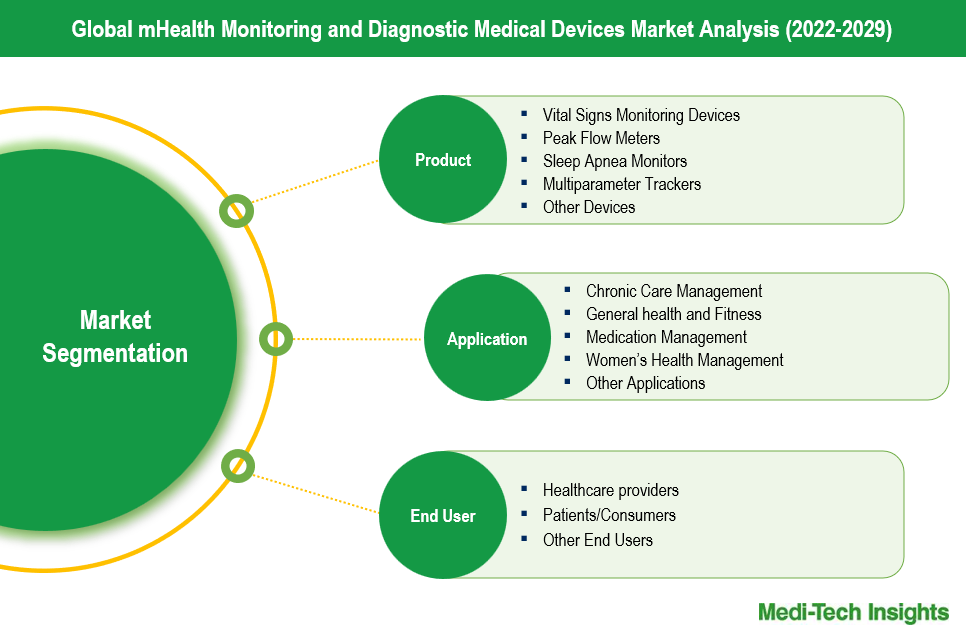
To learn more about this report, download the PDF brochure
Application Type Segment Analysis
The mHealth monitoring and diagnostic medical devices market can be analyzed based on application types, such as chronic care management, general health and fitness, medication management, Women’s Health Management, and other applications. The chronic care management is expected to dominate the market. This is driven by the increasing prevalence of chronic diseases such as diabetes, cardiovascular conditions, and respiratory disorders, which require continuous monitoring and management. mHealth devices offer patients and healthcare providers real-time data and insights, improving disease management, adherence to treatment plans, and overall health outcomes. The need to reduce healthcare costs and hospital visits further propels this segment's dominance. The general health and fitness segment is the likely to grow at a substantial rate. The rise in health consciousness, coupled with the increasing adoption of wearable devices like fitness trackers and smartwatches, fuels this growth. These devices monitor various health metrics, such as physical activity, heart rate, sleep patterns, and more, promoting a proactive approach to health and wellness. Technological advancements, user-friendly interfaces, and the growing trend of preventive healthcare contribute to the rapid expansion of this segment.
Organic and Inorganic Growth Strategies Adopted by Players to Establish Their Foothold in the Market
Players operating in this market are adopting both organic and inorganic growth strategies such as collaborations, acquisitions, and new product launches to garner market share. For instance,
- In May 2024, OMRON Healthcare India partnered with AliveCor India to offer AI-based handheld ECG technology, expanding its product portfolio beyond blood pressure monitors.
- In March 2023, Medtronic plc and NVIDIA entered into a collaboration to integrate NVIDIA's AI technologies into Medtronic’s GI Genius endoscopy module, aiming to enhance AI-assisted colonoscopy and accelerate AI innovation in patient care
- In October 2022, OMRON Healthcare upgraded its blood pressure monitors to connected devices with Bluetooth and the 'OMRON connect' app, enabling seamless, real-time tracking for better hypertension management
- In August 2022, Medtronic plc entered into a strategic partnership with BioIntelliSense for exclusive US distribution of the BioButton wearable, providing continuous vital sign monitoring for hospital and post-acute care patients, enhancing care delivery and clinical intervention
The mHealth monitoring and diagnostic medical devices market is expected to gain further momentum in the coming years due to technological advancements, rising R&D investments, new product launches, and aggressive organic and inorganic growth strategies followed by the players.
Competitive Landscape Analysis: mHealth Monitoring and Diagnostic Medical Devices Market
The global mHealth monitoring and diagnostic medical devices market is marked by the presence of established market players such as Medtronic plc., Bayer HealthCare, BioTelemetry, Inc. (a Philips company), Boston Scientific, Dexcom, Inc., Drägerwerk AG & Co. KGaA, F. Hoffmann-La Roche Ltd, Masimo Corporation, Johnson & Johnson, and iHealth Lab Inc., among others.
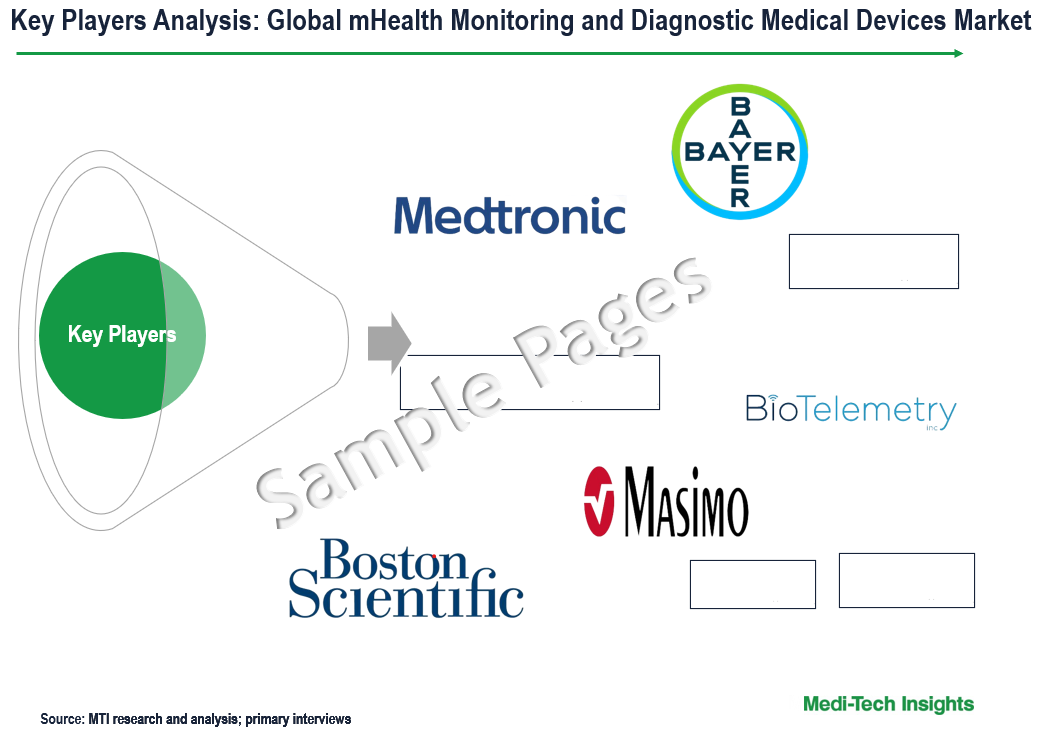
Get a sample report for competitive landscape analysis
Future Outlook of the mHealth monitoring and diagnostic medical devices Market
The global mHealth monitoring and diagnostic medical devices market is expected to gain further momentum in the coming years due to the favorable policies and regulations, demographic that drive demand for remote monitoring and healthcare solutions, increasing healthcare cost and patients taking active roles in managing health with accessible monitoring tools. These factors collectively contribute to the growth and evolution of the mHealth monitoring and diagnostic medical devices market, shaping the landscape of genetic engineering and biotechnology.
mHealth Monitoring and Diagnostic Medical Devices Market Futures and Scope
| Report Scope | Details |
| Base Year Considered | 2023 |
| Historical Data | 2022 - 2023 |
| Forecast Period | 2024 - 2029 |
| CAGR (2024-2029) | 15-17% |
| Segment Scope | Product, Application, End User |
| Regional Scope |
|
| Key Companies Mapped | Medtronic plc., Bayer HealthCare, BioTelemetry, Inc. (a Philips company), Boston Scientific, Dexcom, Inc., Drägerwerk AG & Co. KGaA, F. Hoffmann-La Roche Ltd, Masimo Corporation, Inc., Johnson & Johnson, and iHealth Lab Inc., among others. |
| Report Highlights | Market Size & Forecast, Growth Drivers & Restraints, Trends, Competitive Analysis |
Key Strategic Questions Addressed
-
What is the market size & forecast for the Global mHealth monitoring and diagnostic medical devices Market?
-
What are the historical, present, and forecasted market shares and growth rates of various segments and sub-segments of the Global mHealth monitoring and diagnostic medical devices Market?
-
How has COVID-19 impacted the Global mHealth monitoring and diagnostic medical devices Market?
-
What are the major growth drivers, restraints/challenges impacting the market?
-
What are the opportunities prevailing in the market?
-
What is the investment landscape?
-
Which region has the highest share in the global market? Which region is expected to witness the highest growth rate in the next 5 years?
-
Who are the major players operating in the market? What is the competitive positioning of key players?
-
Who are the new players entering the market?
-
What are the key strategies adopted by players?
- Research Methodology
- Secondary Research
- Primary Research
- Market Estimation
- Market Forecasting
- Executive Summary
- Market Overview
-
- Market Dynamics
- Drivers
- Restraints
- Key Market Trends
- Industry Speaks
- Market Dynamics
- Key Revenue Pockets
- Global mHealth Monitoring and Diagnostic Medical Devices Market - Size & Forecast (2021-2028), By Product Type
- Vital Signs Monitoring Devices
- Blood pressure monitors
- Blood glucose meters
- ECG/heart rate monitors
- Pulse oximeters
- Peak Flow Meters
- Sleep Apnea Monitors
- Multiparameter Trackers
- Other Devices
- Vital Signs Monitoring Devices
- Global mHealth Monitoring and Diagnostic Medical Devices Market - Size & Forecast (2021-2028), By Application Type
- Chronic Care Management
- General health and Fitness
- Medication Management
- Women’s Health Management
- Other Applications
- Global mHealth Monitoring and Diagnostic Medical Devices Market - Size & Forecast (2021-2028), By End User Type
- Healthcare providers
- Patients/Consumers
- Other End Users
- Global mHealth Monitoring and Diagnostic Medical Devices Market - Size & Forecast (2021-2028), By Region
- North America (U.S. & Canada)
- Europe (UK, Germany, France, Italy, Spain, Rest of Europe)
- Asia Pacific (China, India, Japan, Rest of Asia Pacific)
- Rest of the World (Latin America, Middle East & Africa)
- Competitive Landscape
- Key Players and their Competitive Positioning
- Competitive Positioning of Key Players (2022)
- Offerings Assessment, By Player
- Key Strategies Assessment, By Player (2021-2023)
- New Product & Service Launches
- Partnerships, Agreements, & Collaborations
- Mergers & Acquisitions
- Geographic Expansion
- Key Players and their Competitive Positioning
- Key Companies Scanned (Indicative List)
- Medtronic plc
- Bayer HealthCare
- BioTelemetry, Inc. (a Philips company)
- Boston Scientific
- Dexcom, Inc
- Drägerwerk AG & Co. KGaA
- Hoffmann-La Roche Ltd,
- Masimo Corporation
- Johnson & Johnson
- iHealth Lab Inc
- Other Prominent Players
The study has been compiled based on extensive primary and secondary research.
Secondary Research (Indicative List)

Primary Research
To validate research findings (market size & forecasts, market segmentation, market dynamics, competitive landscape, key industry trends, etc.), extensive primary interviews were conducted with both supply and demand-side stakeholders.
Supply Side Stakeholders:
- Senior Management Level: CEOs, Presidents, Vice-Presidents, Directors, Chief Technology Officers, Chief Commercial Officers
- Mid-Management Level: Product Managers, Sales Managers, Brand Managers, Business Development Managers, Consultants
Demand Side Stakeholders:
- Healthcare Providers (Physicians, Nurses), Healthcare IT Professionals, Health Insurance Companies, Patients and Caregivers and Other End Users
Breakdown of Primary Interviews
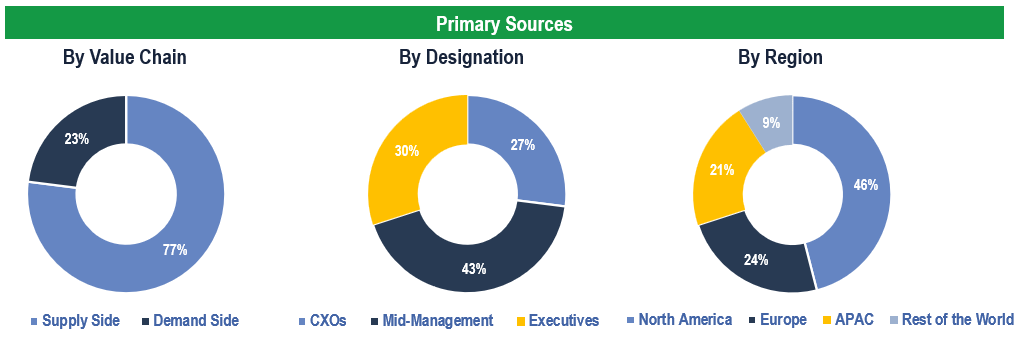
Market Size Estimation
Both ‘Top-Down and Bottom-Up Approaches’ were used to derive market size estimates and forecasts.
Data Triangulation
Research findings derived through secondary sources & internal analysis were validated with Primary Interviews, Internal Knowledge Repository, and Company Sales Data.

